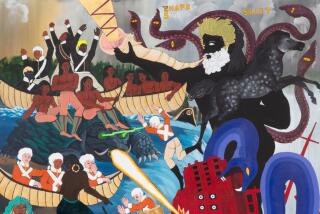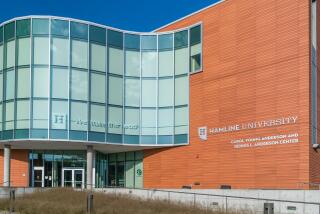A new image of the Koran
Thereâs a long tradition of illustrating scenes from the Bible -- even a version of Genesis by alternative comics master R. Crumb. But the Koran, which Muslims consider to be the holy word of God, has never incorporated images of people or animals, according to Linda Komaroff, curator of Islamic art at the Los Angeles County Museum of Art.
âIt simply wasnât the kind of thing that would come up,â she said, âIn Islam, like Judaism, thereâs one invisible god thatâs everywhere, that canât be seen and canât even be comprehended.â As a result, there was no need to develop figurative imagery for religious purposes. The Koran, said Komaroff, is regularly decorated with geometric or vegetal patterns, but she has seen only one example that contains more representational imagery. It depicts the facade of a mosque.
Now, Long Beach artist Sandow Birk has challenged that centuries-old tradition. His series of works on paper, âAmerican Qurâan,â is an English-language version of the central text of Islam, illustrated with scenes from contemporary American life. Selections from the project, which is ongoing and will eventually include over 300 pages, will be on view at Catharine Clark Gallery in San Francisco starting Sept. 5 and at Koplin Del Rio gallery in Culver City as of Sept. 8.
Executed in ink and gouache in an understated, realist style, many of the 16-by-24-inch works depict everyday sights -- urban street life, office workers in their cubicles, a pregnant couple in their frontyard. Others represent more historic moments, such as the smoking towers of the World Trade Center or a funeral with a casket draped in a U.S. flag. In the center of each image are two neatly framed boxes containing the text, hand-lettered in a font reminiscent of graffiti writing.
Although the Koran does not prohibit the creation of images, it does contain an injunction against the making of idols, and the faithâs second most important text, the hadith, includes additional restrictions on the use of figurative imagery, said Komaroff. Whether âAmerican Qurâanâ violates these decrees seems to be a matter of interpretation.
Birk was not available for comment, but a statement on Koplin Del Rioâs website said that although he followed âtraditional guidelinesâ for color, formatting and decoration, â âAmerican Qurâanâ is not to be considered a âHoly Qurâanâ in that it does not contain the original text in Arabic.â
Komaroff had doubts about this claim. The Koran, she said, âwasnât meant to be restricted to those who could only understand or read Arabic. It was meant to be a universal message. So I donât know that itâs correct to say if you render it in English that it takes away its sacredness.â
Mohammad Qureshi, an administrator at the Islamic Center of Southern California, had a stronger reaction. âThat is not acceptable at all,â he said after viewing images of the project on Birkâs website. He was particularly concerned about images of a liquor store and a woman he described as âhalf-naked,â and thought they would be offensive to Muslims.
Controversy is familiar terrain for Birk, who for the last 20 years has used art historical references to address contemporary social issues, creating ironic, sometimes surreal images of gang culture, prisons and the war in Iraq. A native of Orange County and a 1988 graduate of the Otis College of Art and Design, he is well known on the West Coast and has a growing international profile. Many of his projects involve extensive periods of research and travel, and his interest in the Koran stems from his visits to Muslim countries and to prominent collections of Islamic art over the last 10 years.
Yet âAmerican Qurâanâ is a bit of a departure for the artist in that its intent is neither ironic nor critical, said Darius Spieth, an associate professor of art history at Louisiana State University who has followed Birkâs career for over a decade. âWhat heâs after is more of an educational project,â Spieth said, âAlthough Islam is the fastest-growing religion in the U.S. currently, most Americans do know relatively little about it, and I think thatâs also kind of his mission.â
--
More to Read
The biggest entertainment stories
Get our big stories about Hollywood, film, television, music, arts, culture and more right in your inbox as soon as they publish.
You may occasionally receive promotional content from the Los Angeles Times.










